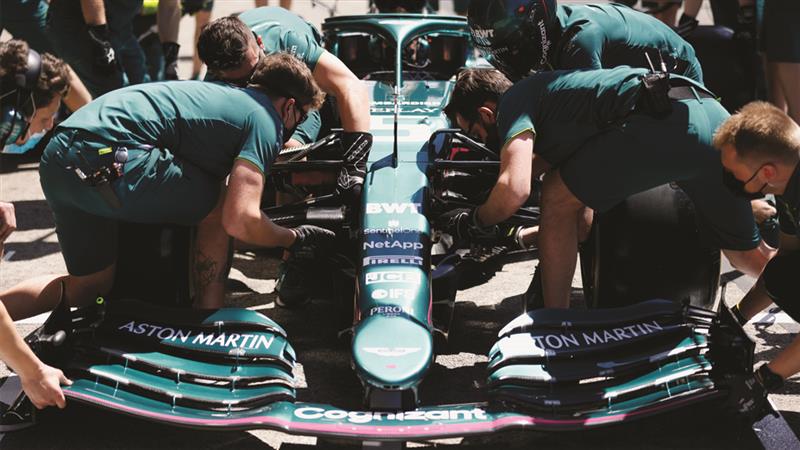How will Aston Martin Cognizant Formula One Team move to the front of the starting grid? Data, sweet data


James Whitemore

We're slightly different from most businesses in that we're not revenue driven per se. It's all about performance and that performance, not just on the car, distills down to everything we do in the business.— Bill Peters, CIO, Aston Martin Cognizant Formula One Team
Anyone who’s tuned in to the hugely popular Netflix docuseries, Drive to Survive, has been treated to a never-before-seen glimpse into Formula One’s paddock and the teams battling for glory. Well, NetApp CIO Bill Miller recently sat down with Bill Peters, CIO of Aston Martin Cognizant Formula One Team (AMCF1), who pulled back the curtain even more to reveal just how important data is in the F1 game, and how the team’s partnership with NetApp is primed to help it gain performance and win championships.
Although 2021 marks Aston Martin’s long-awaited return to the F1 grid, Bill Peters has continuously led IT in support of F1 and motorsports racing teams, including McLaren, Lotus, Caterham, and BWT Racing Point, for more than two decades. On joining AMCF1, he says, “This latest chapter is the cream on the cake for me—I've been a fan of Aston Martin forever.”
To say that F1 teams generate a lot of data would be a gross understatement. On a race weekend alone, you have, in essence, a virtual pit wall stretching from trackside to factory. First, race engineers are in constant communication with drivers about the program they’re running, conditions, and track decisions. Control engineers and performance engineers monitor vital statistics about the car and how the car and driver are performing so that drivers can make real-time adjustments.
Next, you have strategy engineers who use advanced tools to try to predict what will happen, and adapt quickly when there’s a crash, safety car, or unplanned pit stop. And finally, tire analysts, aero performance engineers, and vehicle performance engineers analyze real-time data coming off the car so they can feed back vital information for their specialty.
According to Bill, that’s not all. “You also have parallel simulations going on in the factory, which requires delivering subsets of the data in near-real time so people there can do their analysis on it.”
When race weekend ends, the data doesn’t stop flowing. Take aerodynamic performance, for example. New concepts are first vetted using computational fluid dynamics (essentially a virtual wind tunnel). If positive results are generated, scaled-down prototypes are created and put through an actual wind tunnel. If that phase looks very promising, the team builds full-size components, puts those onto the car, gathers more data, and correlates the results back to the wind tunnel.
Step into the AMCF1 factory and you’ll also find a dynamics simulation area for testing components, rigs that shake cars for endurance testing, and structural and tire analysis departments. All of these areas create vast amounts of data that needs to be analyzed, correlated, and turned into decisions. “The faster and better we are than our competition at doing these things, the more competitive our cars will be,” says Bill.
The team turned to NetApp because—from trackside to factory—much of its data is currently siloed. Data is generated and used where it's actually needed, but the team has struggled to get correlation across that data.
According to Bill, they translated their passion for the NetApp® data fabric concept into a “racing fabric” that “really fits with what we're trying to achieve…. To have the right storage and compute for the right workloads and where they're needed, and then making them all talk together as seamlessly as possible.”
He says it’s not just about the data pipeline and infrastructure that NetApp will help them achieve. From an edge computing perspective, instead of having to ship data back, processing it at the source will be an immediate advantage for the team.
Kubernetes is another platform he sees the team leveraging with NetApp’s help. For example, they can repurpose the trackside environment between race weekends for heavy GPU workloads, like machine learning and data crunching analytics.
Bill Peters knows how to win world championships. He believes that with AMCF1’s people, passion, resources, and a data strategy supported by NetApp, they can compete with the big teams, beat them, and help him win at least one more championship.
For the full Bill Peters interview, watch the CIO Central podcast.
https://youtu.be/rmVIFKwkHeo
James Whitemore
James Whitemore is the Chief Marketing Officer at NetApp. He is responsible for advancing the company’s global marketing strategy and strengthening market recognition to accelerate growth. As a veteran of the cloud computing, networking and storage industry, James has more than 25 years of experience leading and implementing successful global sales, product management and marketing strategies. A key part of the team since joining NetApp via the SolidFire acquisition in early 2016, James has been central to the development and execution of our Marketing strategy to reposition NetApp from storage to data and the cloud. In his previous role as VP of Field & Demand Marketing at NetApp, James built and led a modern demand engine as well as managed Field and Partner Marketing, Demand Centers, Global Campaigns, Event Marketing, Digital Marketing, Social, Influence and Community Marketing. As CMO at SolidFire, James led the mission to advance the way the world uses cloud and was responsible for all corporate, product, and field marketing functions. Prior to SolidFire, James has led sales and marketing functions in cloud orientated start-up companies holding a variety of sales and marketing positions in Europe, Asia and the U.S. with SAVVIS, Sun Microsystems, IBM, StorageTek and Standard Telephones and Cables. James holds a bachelor’s degree in business administration and management from Northumbria University in the UK.